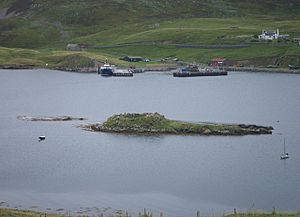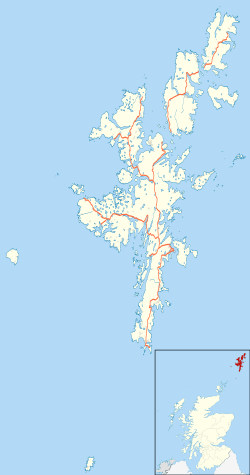Broch of West Burrafirth facts for kids

Remains of the broch on the little holm
|
|
| Location | Mainland, Shetland |
|---|---|
| Coordinates | 60°17′53″N 1°32′18″W / 60.298185°N 1.538235°W |
| Type | Broch |
| History | |
| Periods | Iron Age |
The Broch of West Burrafirth is an ancient stone tower from the Iron Age. It is located on the west side of Mainland, Shetland, an island in Scotland. Brochs are special buildings found only in Scotland, built by people who lived there thousands of years ago.
Where is the Broch of West Burrafirth?
This broch stands on a small, rocky island called the "Holm of Hebrista." This island is located in a narrow sea inlet known as West Burra Firth. You can only reach the broch by boat, unless the tide is extremely low. Long ago, there might have been a path or bridge connecting the island to the shore, but it's not visible anymore.
What does the Broch look like?
The Broch of West Burrafirth is quite old and is now mostly in ruins. This means many parts of it have fallen down over time. The entrance to the broch is currently blocked by stones. However, you can still see the large stone that formed the top of the doorway, called a lintel.
Inside the broch, there are signs of small rooms or spaces. Near the entrance, there seem to be two "guard cells," which were small rooms on either side of the main passage. Deeper inside, you can see four "mural cells." These are rooms built into the thickness of the broch's walls. Two of these cells are shaped like a "dumb-bell," with two round parts connected by a short passage. This ancient site is protected as a scheduled monument, meaning it's an important historical place.
A Glimpse into the Broch's Past
The Broch of West Burrafirth has a long history, even appearing in old stories! The Orkneyinga saga, an ancient Norse tale, mentions this area. It talks about two leaders, Magnus Erlendsson and Hákon Paulsson, who ruled their lands together.
The Vikings, who were Norse explorers and settlers, called this area "Borgarfjörð." This name means "fjord of the borg," with "borg" referring to the broch itself. This shows how important the broch was to them. It was likely used as a safe place or a defensive spot for people living there. An old document from 1299, written in the Norse language, also uses the name Borgarfjörð.
In the 1700s, a man named George Low visited the broch. He wrote down what he saw, noting several rooms at the bottom of the walls. He also mentioned that above these rooms, the wall was hollow and had a gallery, which is like a walkway inside the wall.


